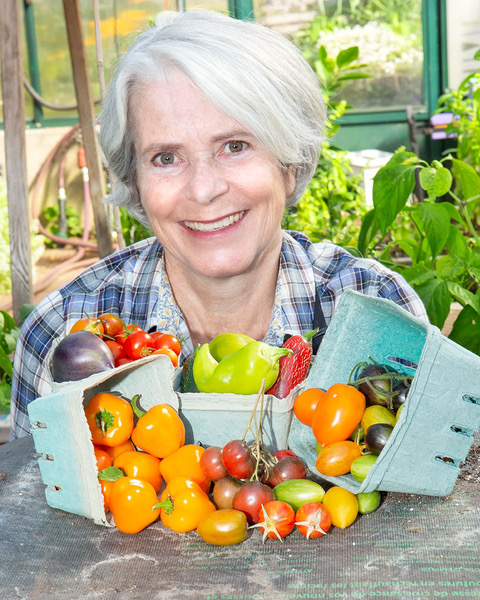“Indeterminate” tomatoes continue to grow taller and taller over the course of a season and eventually create picking problems for greenhouse growers, fall over when tomato harvest is too heavy or shade the plants around them as they stretch to the roof, reaching heights of ten feet or beyond. Eventually gardeners are forced to prune them to restrict the height but now we have a new class of tomato that eliminates the extra work of pruning.

Dwarf tomato plants are easier to tie in a greenhouse because they have a maximum height of 3-4 feet tall (1M-1.25 M)
About ten years ago the dwarf tomato project started developing new shorter varieties that are not determinate. This is important because it means they will keep producing tomatoes as they grow unlike determinate kinds that produce a single crop, all at once.
The dwarf kinds reach a set height of 3-4 feet and then stop growing. This way, gardeners can reliably support their plants with simple tomato cages or stakes instead of tying plants metres in the air with strings tied to the roof or having one big crop all in one week. Because I love to grow tomatoes in my greenhouse and also want to grow trays of plants on shelves above my plants in the same greenhouse I am super intrigued by this idea.
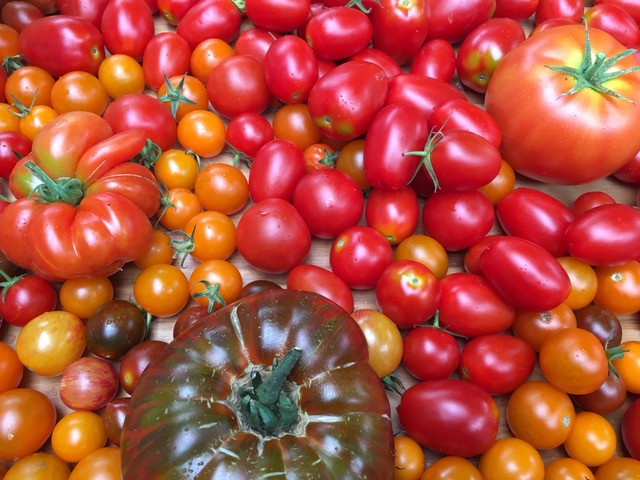
These are some of the numerous kinds of tomatoes I have grown in my greenhouse in the past. This year I am adding some of the heat tolerant dwarf tomatoes to my greenhouse
Once I dig in I discover there are 139 varieties listed on the Dwarf Tomato Project website and I know I can’t try them all. I specifically want to try a few new varieties for my greenhouse without reading all the many plant descriptions so I ask an artificial intelligence program to suggest the top ten dwarf tomato varieties suitable for greenhouse growing. It is important to note that not all of the dwarf plants are specifically bred for heat tolerance. However, there are still several varieties that have been shown to perform well in high-temperature environments. According to the Artificial Intelligence program ChatGPT here are 10 of the best tomato plants that will thrive in the heat of my greenhouse:
1 ‘Dwarf Beryl Beauty’ – This determinate variety produces medium to large, red tomatoes that have a sweet, fruity flavor. It is known for its heat tolerance and productivity.
2 ‘Dwarf Golden Gypsy’ – This determinate variety produces medium to large, golden-yellow tomatoes that have a sweet, tangy flavor. It is known for its heat tolerance and disease resistance.
3 ‘Dwarf Golden Heart’ – This determinate variety produces medium to large, golden-yellow tomatoes that have a sweet, mild flavor. It is known for its heat tolerance and productivity.
4 ‘Dwarf Pink Passion’ – This determinate variety produces medium to large, pink tomatoes that have a sweet, fruity flavor. It is known for its heat tolerance and disease resistance.
5 ‘Dwarf Red Robin’ – This determinate variety produces small, red cherry tomatoes that are perfect for snacking. It is known for its heat tolerance and productivity.
6 ‘Dwarf Wild Fred’ – This indeterminate variety produces medium to large, pink-red tomatoes that have a sweet, fruity flavor. It is known for its heat tolerance and disease resistance.
7 ‘Dwarf Russian Swirl’ – This indeterminate variety produces medium to large, red tomatoes that have a sweet and tangy flavor. It is known for its heat tolerance and productivity.
8 ‘Dwarf Pink Passion Striped’ – This determinate variety produces medium to large, pink and yellow striped tomatoes that have a sweet, fruity flavor. It is known for its heat tolerance and disease resistance.
9 ‘Dwarf Blazing Beauty’ – This determinate variety produces medium to large, orange-red tomatoes that have a sweet, tangy flavor. It is known for its heat tolerance and productivity.
10 ‘Dwarf Sweet Sue’ – This determinate variety produces medium to large, red tomatoes that have a sweet, low-acid flavour. It is known for its heat tolerance and disease resistance.
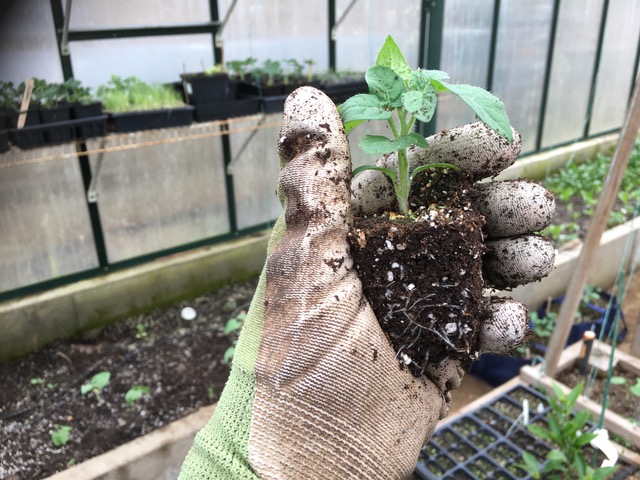
Growing perfectly stocky and healthy seedlings is step one to getting a great harvest of tomatoes in your greenhouse
I decide to choose three varieties and have already discovered I don’t like green, pink or yellow tomatoes so I consider Dwarf Beryl Beauty, Dwarf Russian Swirl and Dwarf Blazing Beauty for my list before I realize Beryl Beauty is a green tomato so I cross it off. Dwarf Russian in unavailable in the sources I investigate so I can’t get it. I also have a strong dislike for potato-leaf types of tomatoes and Dwarf Blazing Beauty has the wispy potato leaves I so dislike. I cross it off my list and suddenly I am reading all 139 descriptions.
Eventually I order Dwarf Audrey’s Love, Rosella Purple. Sarandipity and Dwarf Red Robin (the only one listed above as suitable for greenhouse growing.) Check back in the fall and I will include photos of these new plants plus the standbys I love to grow.
Under excessive heat (a period called the “heat dome” a few years ago in my area), I was able to keep my greenhouse cooler than outdoor temperatures, optimizing tomato growth. Keeping greenhouse temperatures below 95F (35 C), means less flower drop and more ripe tomatoes. I use several strategies:
1 Shade cloth: Installing shade cloth over your greenhouse can help reduce the amount of sunlight that enters the space, keeping it cooler.
2 Boosting ventilation: Good ventilation is essential for maintaining a cool and healthy greenhouse. Open windows and doors, use fans, or install a ventilation system to circulate air and remove excess heat.
3 Water more often: Keeping the soil moist can help keep the air in your greenhouse cool, as the water evaporates from the soil. Since tomatoes are almost always thirsty and it is rare to overwater them, this is a very easy approach if you have the time to water daily.
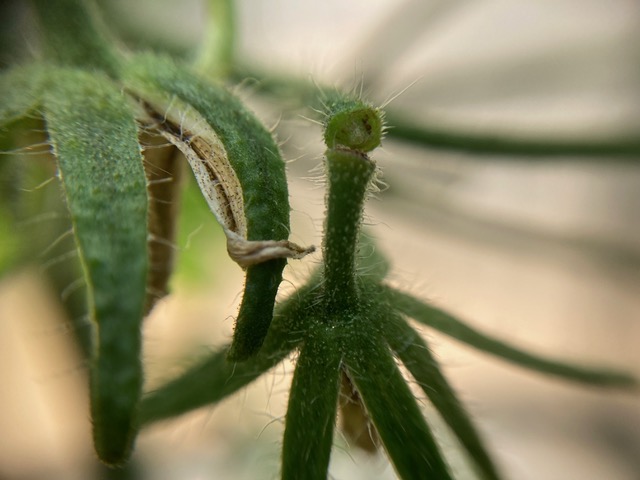
When temperatures exceed 95 F (35 C) the flower buds snap off and the tomatoes fail to grow. This happened during the heat dome a few years ago so I cool my greenhouse with shade cloth, fans and water.
By selecting the right tomato varieties and implementing cooling strategies, I grow healthy and productive tomato plants in my greenhouse even in the heat of summer. This year I am adding dwarf varieties to my favourites and hope to report even more success next fall.
PS Tomato start dates vary by region because tomatoes can’t tolerate frost, and last frost dates are different in different regions. I usually start my greenhouse plants before mid-April and harvest from July to October.
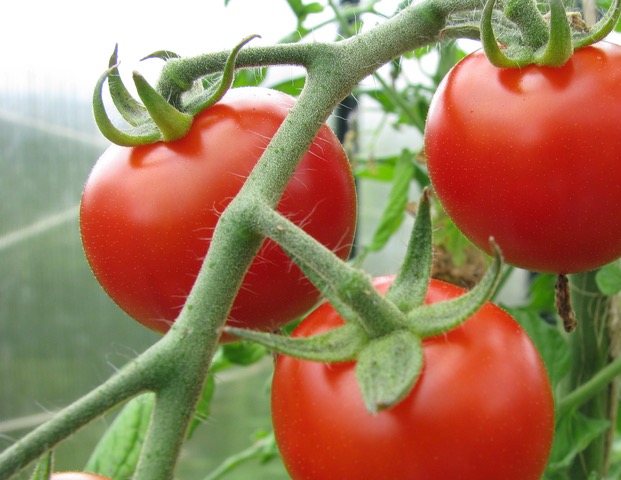
Healthy, red tomatoes in my greenhouse are usually pest-free and glossy.

Tomatoes grown outdoors are often attractive to feeding rodents like rats and squirrels
